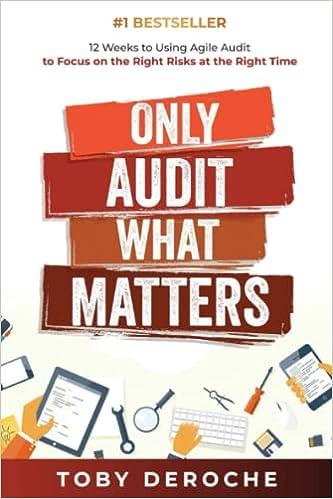
- Use the notes to the financial statements to determine which cost flow inventory method the company uses for most of its inventory?
| | | FIFO |
| | | LIFO |
| | | Weighted average |
| | | Specific identification |
- Assuming increasing prices, is the companys reported inventory higher or lower than if the firm used a different method? What is the rationale (explain)?
| | | Unchanged. Rising prices have no relationship to the reported inventory. |
| | | Lower. Lower priced inventory is left in inventory therefore it is lower. |
| | | Higher. Lower priced inventory is mixed with higher priced inventory, so the overall inventory increases in value. |
| | | Higher. In a period of rising prices, higher (newer) priced inventory remains in the inventory account. |
- Assuming increasing prices, is the companys reported net income higher or lower than if the firm used a different method? What is the rationale (explain)?
| | | Lower. As mentioned in # 8 prices have no relationship to reported inventory. |
| | | Lower. As mentioned in # 8 lower priced inventory is left in inventory therefore everything is lower throughout the financial statements. |
| | | Higher. The method transfers first (lower cost) items to the COGS in the income statement, resulting in a higher gross margin and higher net income. |
| | | Higher. The method first transfers last (higher cost) items to the COGS in the income statement, resulting in a higher gross margin and higher net income. |
Libbey Inc. Notes to Consolidated Financial Statements 1. Description of the Business Libbey is a leading global manufacturer and marketer of glass tableware products. We produce glass tableware in five countries and sell to customers in over 100 countries. We design and market, under our Libbey, Libbey Signature, Master's Reserve, Crisa8, Royal Leerdam WorldTableware, SyracuseChina and Crisal Glass brand names (among others), an extensive line of high-quality glass tableware, ceramic dinnerware, metal flatware, hollowware and serveware items for sale primarily in the foodservice, retail and business-to-business markets. Our sales force presents our tabletop products to the global marketplace in a coordinated fashion. We own and operate two glass tableware manufacturing plants in the United States as well as glass tableware manufacturing plants in Mexico Libbey Mexico), the Netherlands (Libbey Holland), Portugal (Libbey Portugal) and China (Libbey China). In addition, we import tabletop products from overseas in order to complement our line of manufactured items. The combination of manufacturing and procurement allows us to compete in the global tabletop market by offering an extensive product line at competitive prices. 2. Significant Accounting Policies Basis of Presentation The Consolidated Financial Statements include Libbey Inc. and its majority-owned subsidiaries (collectively, Libbey or the Company). Our fiscal year end is December 31 s. All material intercompany accounts and transactions have been eliminated. The preparation of financial statements and related disclosures in conformity with United States generally accepted accounting principles (U.S. GAAP) requires management to make estimates and assumptions that affect the amounts reported in the Consolidated Financial Statements and accompanying notes. Actual results could differ materially from management's estimates. Revenue Recognition Revenue is recognized when products are shipped and title and risk of loss have passed to the customer. Revenue is recorded net of returns, discounts and incentives offered to customers. We estimate returns, discounts and incentives at the time of sale based on the terms of the agreements, historical experience and forecasted sales. We continually evaluate the adequacy of these methods used to estimate returms, discounts and incentives. Taxes collected from customers are excluded from revenues and credited directly to obligations to the appropriate govermmental agencies. Cost of Sales Cost of sales includes cost to manufacture and/or purchase products, warehouse, shipping and delivery costs and other costs. Cash and Cash Equivalents We consider all highly liquid investments purchased with an original or remaining maturity of less than three months at the date of purchase to be cash equivalents. Cash and cash equivalents are maintained with various financial institutions. Accounts Receivable and Allowance for Doubtful Accounts We record trade receivables when revenue is recorded in accordance with our revenue recognition policy and relieve accounts receivable when payments are received from customers. The allowance for doubtful accounts is established through charges to the provision for bad debts. We regularly evaluate the adequacy of the allowance for doubtful accounts based on historical trends in collections and write-offs, our judgment as to the probability of collecting accounts and our evaluation of business risk. This evaluation is inherently subjective, as it requires estimates that are susceptible to revision as more information becomes available. Accounts are determined to be uncollectible when the debt is deemed to be worthless or only recoverable in part and are written off at that time through a charge against the allowance. Generally, we do not require collateral on our accounts receivable Inventory Valuation Inventories are valued at the lower of cost or market. The last-in, first-out (LIFO) method is used for our U.S. glass inventories, which represented 32.2 percent and 29.1 percent of our total inventories in 2017 and 2016, respectively. The remaining inventories are valued using either the first-in, first-out (FIFO) or average cost method. For those inventories valued on the LIFO method, the excess of FIFO cost over LIFO, was $13.4 million and $12.9 million in 2017 and 2016, respectively. Cost includes the cost of materials, direct labor, in-bound freight and the applicable share of manufacturing overhead. Purchased Intangible Assets and Goodwill Financial Accounting Standards Board Accounting Standards CodificationTMFASB ASC") Topic 350 "Intangibles- Goodwill and other" FASB ASC 350") requires goodwill and purchased indefinite life intangible assets to be reviewed for impairment annually, or more frequently if impairment indicators arise. Intangible assets with lives restricted by contractual, legal or other means will continue to be amortized over their useful lives. As of 54







